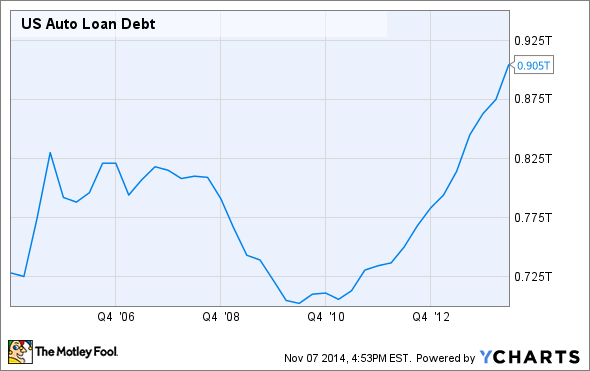
Image source: Wikimedia Commons/TheBrockenInaGlory
This week the Federal Reserve released its quarterly Senior Loan Officer Survey, in which top banking officials report a boots-on-the-ground take on the supply-and-demand dynamics across the banking industry.
This quarter's report saw banks easing their lending standards across the board, from credit cards to mortgages to business loans. When banks make it too easy to get a loan approval, the basis for a bubble forms. Is any corner of the market getting a little too frothy for comfort? Let's dig into the numbers and find out.
Assuming that demand keeps up with supply
According to the survey, banks are also seeing a continuation of weak demand for mortgage loans. So we can collectively breath a sigh of relief: Housing Bubble 2.0 is not on the horizon yet.
Banks reported moderate increases in demand for other consumer and business debt, but nothing that would indicate a possible bubble -- except for one segment.
Auto loans.
The net percentage of banks reporting increases in demand for auto loans increased to 25.4% this quarter, continuing a trend that's been in place for several years now. Low interest rates, easing lending standards, and increasing consumer demand create a foundation that could grow into a big bubble.
The New York Times reported this week that borrowers are increasingly taking out auto loans for upwards of six or even eight years instead of the traditional three- to five-year auto loan terms. For banks, this easing of terms means increasing risks as the value of the car depreciates and the ability to forecast repayment decreases over longer time horizons.
Financing is back in a big way
Before the Great Recession, 70% of new auto loans were sold with a loan, 27.5% with a lease, and the remainder all in cash.
During the recession, the percentage of loans and leases declined to 63% and 21%, respectively. This was in large part due to government programs such as "Cash for Clunkers" that freed up money for consumers to buy with more cash. At the same time, though, banks tightened lending standards as the industry fought to survive the recession.
Today, after the dust of the recession has by and large settled, the percentage of new car purchases has rebounded, but the dynamic has shifted. Today, about 66% of purchases are with a loan, 29% with a lease, and the remainder in cash.
US Auto Loan Debt data by YCharts
Part of the return of financing can be explained by low interest rates, but easing lending standards also have had a major impact. Easier loan approvals seem to have replaced the heavy incentives on new car purchase programs that manufacturers previously offered. Gone are the discounts, rebates, and manufacturer financing at basically 0% rates, replaced by eight-year loan terms at 3% interest rates.
Summarizing what we've established thus far, we can see that banks are making loan approvals easier and people are again borrowing money for auto purchases at pre-recession levels. These two conditions are not in and of themselves problematic, so long as the loans being originated are high quality.
Subprime all over again
Economists generally split consumer loans into three tiers based on consumers' credit history. There are prime loans given to borrowers with credit scores above 680, near-prime loans to borrowers with scores between 620 and 679, and subprime loans to borrowers with scores below 620.
At the beginning of 2010, just under 90% of new car financing were to prime borrowers -- those borrowers with the highest likelihood of timely repayment. That number as of June 30 stood at just 60%.
Over that same time period, near-prime borrowing increased from 9% to 20% of new car financing. Subprime borrowing increased even more, jumping from 4% to 20%.
Banks are easing standards, buyers are financing their auto purchases with increasing levels of debt, and the real growth in borrowing is coming from borrowers with poor credit history.
What's the risk to bank investors?
Fortunately for investors, the banking industry is far less reliant on auto lending than it is on mortgage lending. If a theoretical auto bubble were to burst, the downside risk is far, far less than what happened when the housing bubble burst in 2008.
According to data from the FDIC's required quarterly bank filings, the entire banking industry has just 4.65% of all loans in auto purchases by individuals. That compares with nearly 22% in 1-4 Family Real Estate and 21% in business loans (called "commercial and industrial" in industry parlance). On the whole, the auto lending niche isn't large enough to pose a systemic risk.
Of course, every bank is unique, and some will have higher concentrations than others.
Regional lender BB&T (TFC 3.05%), for example, reports in its quarterly filings with the FDIC that just 6.8% of its entire loan portfolio consists of auto loans to individuals. That compares with 29% of the loan portfolio secured by 1-4 Family Real Estate.
Huntington Bancshares (HBAN 0.76%), on the other hand, reports a 17.8% concentration of auto loans to individuals versus 17.4% secured by 1-4 Family Real Estate.
So is this a bubble? It's impossible to know until it bursts. Interest rates will rise eventually, which in all likelihood will push many subprime borrowers out of the market and bring the percentage of prime borrowers back to historical norms. In the meantime, though, it's worth taking the time to dig in to your bank stock's loan portfolios just so you know how much exposure you have if the bubble were to burst.






